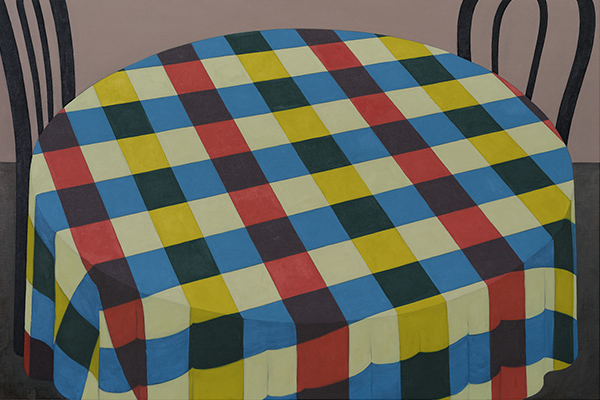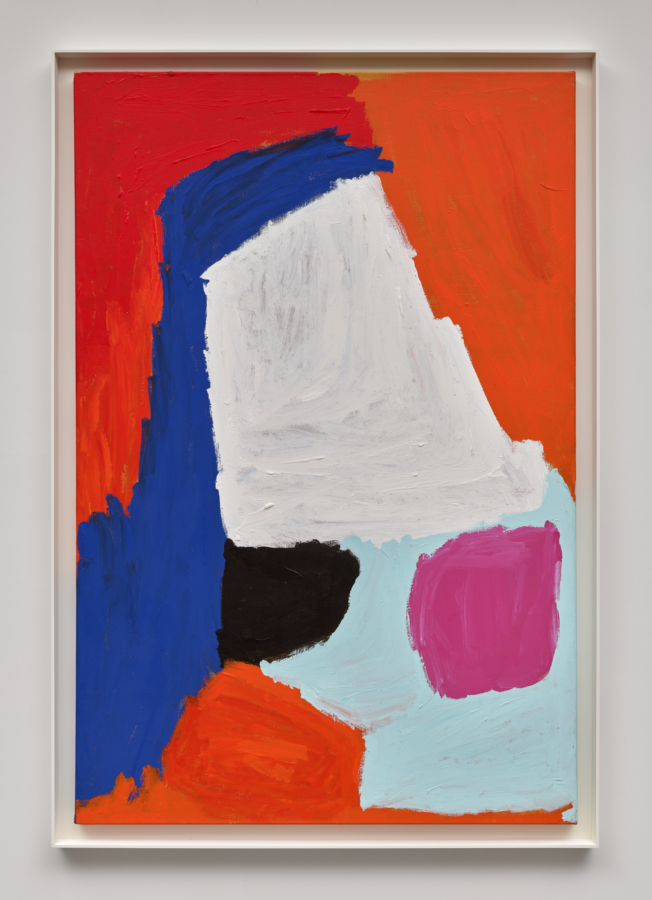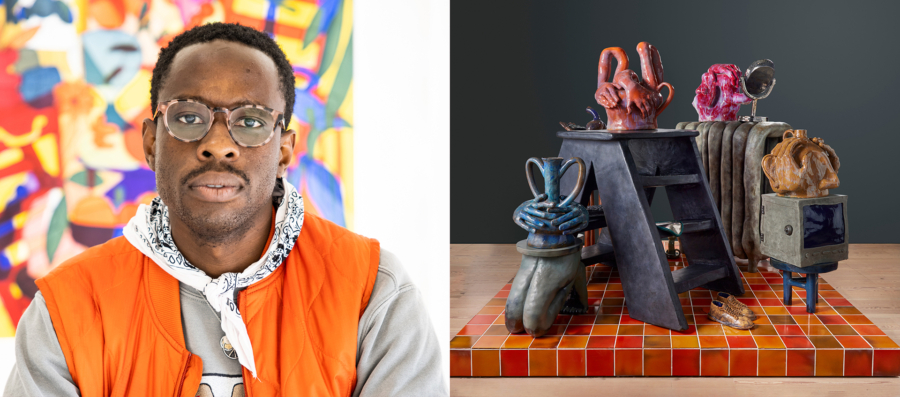2016
Sports Book, Anton Kern Gallery, New York, NY and David Kordansky Gallery, Los Angeles, CA, 2016
Jonas Wood reinterprets some of the traditional genres of painting, such as portraiture, still life and domestic scenes, but he expands them towards absolutely unusual directions. His work pursues an imaginary realism, a personal universe in which the most intimate can intersect with the most public, the personal with the collective. The modest, at times bleak views of Wood’s par- ents house can coexist with universal icons of celebrity. It is an infantile universe that Wood is painting, where the private space of his childhood bedroom almost magically overlaps with the world of basketball stars and sports legends. Drawing on this fascination, Wood explores an America in which the dream of success blends with atmospheres of daunting ordinariness.
Born in 1977 in Boston, Massachusetts, Wood studied art at the University of Washington before moving to Los Angeles, where he currently lives. The iconography of typically American sports such as basketball and baseball, with their corollary of televised spectacles, ephemera and fan’s clubs, constitutes one of Wood’s favorite sources of inspiration. Live matches, TV programs and specialized magazines–both new and old–make up Wood’s imagery, onto which are grafted autobiographical memories and personal stories. There is, in fact, always a rather nostalgic atmosphere in Wood’s paintings, a muffled tone that suggests a fairly intimate, even private relationship between the artist and his subjects. It is not the flashy, steroids–induced perfection of sports that fascinates Jonas Wood: in fact his athletes have nothing heroic about them. Instead, they are turned into mysterious creatures, like giant insects flattened out on canvas or Byzantine divinities decomposed in a mosaic of colors.
Wood is certainly a sport fanatic and a passionate fan of any possible competition: one can easily figure that out by looking at the subjects of his drawings and paintings–from home town Boston Celtics legend Larry Bird to baseball cards, from poker games to blood- thirsty boxing matches. Wood entertains a sentimental relationship with his sources- be it a TV program or a poster he had in his room as a child: it is both a private love story and a form of pagan devotion that Wood stages in his canvases–a secular adoration, as though he were to create his own Olympus of new, crippled gods and deformed idols.
The bodies that Wood likes to paint, in fact, are often strangely stretched out, their proportions slightly awkward, and it’s hard to tell whether these anatomical oddities. are the result of Wood’s style or if they are faithful representations of characters who are both literally and metaphorically larger than life. Take, for example, the watercolor M.Bol (Warriors Days) (2007). Wood freezes Manute Bol-who, at seven feet and seven inches, is the tallest basketball player in the history of the NBA-in a watchful stance, his hands resting on his knees as he follows the game from a distance. Rendered with large brushstrokes and vast expanses of flat colors, the player appears transformed into a bizarre, somehow alien celebrity, immediately recognizable yet completely changed: He stands as a tired hero against a background that has been fragmented into an abstract puzzle of stains, the crowd exploded into a patchwork of shapes and colors. The same player is the main character in the painting entitled Bullets (2007), which reproduces a well-known image of Washington Bullet teammate Muggsy Bogues, respectively the shortest player in NBA history and the quite differently scaled Bol. The two stand next to each other, holding three basketballs in a balancing act that has something absurdly slapstick to it. The athletes’ elongated limbs and shadows cut the pictorial space vertically, their bodies rising like isolated totems from an unknown past. Manute’s hands are transformed into menacing claws, his smile into a distorted, almost cubist grimace. In other works such as Young Yao (2007) and D. Mutumbo (2007), Wood portrays other players and athletes of exceptional height. Wood’s rendering of their anatomic features is swift and prompt, as though he was painting from memory and couldn’t waste a single instant before hitting the canvas with his brush. Then again, once the unconventionality of the subject matter has receded in the background, one realizes that Wood uses the human figure only as an excuse to construct a pictorial surface that is expertly abstract, like an intricate inlay work in which different patterns are combined.
Seen from up close, Wood’s paintings have a lo-fi quality to them: they swarm. with cells of intense hues-the surface of the painting is dissected into large regions of color, transforming the canvas into a strange, non-figurative map. The absence of chiaroscuro and the sharp edges of his color planes turn his paintings into a brightly animated chessboard. Wood’s rendering of the background deserves special attention. While the main subject of his work is always immediately recognizable in spite of its somehow stylized treatment, the crowd in the background is often erased from the picture. There is something hallucinatory in Wood’s backdrops, which are pointillist detonations of colors. In Number One Draft Pick (2008), for instance, Trail Blazers player Greg Oden is immortalized as he is about to shoot a free throw. Behind him, round shapes of orange and blue are there to remind us of the jubilant crowds cheering for their team, but they also function as purely abstract diversions, something akin to a vernacular adaptation of color field painting inserted in the most mundane of subjects.
It is an absolutely personal ballet of realism and abstraction that Wood performs: a heightened form of perception that turns figurative painting into a peculiar form of disfiguration. It’s color field painting by the way of Le Douanier Rousseau.
Wood’s complex dance between abstraction and figuration is made even richer by his use of various techniques such as gouache, colored pencil and collage on paper, often adopted in the very same work. Wood is not interested in the shiny, photogenic rhetoric of sports. He could not be more distant from Andreas Gursky’s hyper–visibility or from Paul Pfeiffer’s televised gaze, just to mention two artists who have recently devoted entire bodies of work to the world of sports. Wood’s optical tours de force rely on a much slower and more intimate technique. The genesis of each work of his is, in fact, extremely stratified. The artistic process is staged through a complex system of different steps, and is developed by combining drawing, handmade photo–collage, and painting. Each of these techniques can give birth to a different work of the same subject, and in its various incarnations the same subject can serve as the source material for another work, so that the artist, for example, while painting, will no longer look at the original source image-being a baseball card or a stock image–but will instead depart from his own first hand material, that can be a photo–collage, a drawing or painting. Take, for instance, Daisuke Matsuzaka (2007), a portrait of the Japanese baseball player. Wood first explored this subject in a work on paper, realized with pencil and watercolors. In the original watercolor one can easily see a large water spot right behind the athlete’s figure. When Wood decided to make a painting of the same subject, he used the watercolor and not the original photograph as a source image, and he ended up reproducing on canvas the large water stain from the watercolor, just behind the player’s left shoulder.
This attention to detail is typical of Wood’s approach to painting. After all, his fascination with sports could be not just a matter of private obsessions, but also an attraction for an enclosed, complete system that allows him to explore small variations and lateral movements. As the complex construction of his paintings suggest, Wood is a structuralist: he is interested in the ways different parts and details can be combined to create a whole.
Wood’s experiments with photo collage are a primary example of this approach. Usually Wood uses these collages as a starting point for his watercolors and paintings. Realized by cutting and pasting different photos of the same room or portrait, Wood’s collages create a sort of wide-angle effect, like an extended perspective in which any sense of depth is erased and the image- fragmented in a kaleidoscope-seems to press to the foreground. Wood’s photo-sketches echo David Hockney’s collages of polaroids. In the seventies and eighties Hockney worked on a series called “Joiners”, which consisted of patchworks of small photographs of the same subject that composed a fractured image. The resulting picture-an enlarged cubistic view of a landscape, for instance-encapsulated multiple perspectives and a sense of temporal duration. Although Wood’s technique is in many ways referable to Hockney’s, Wood adopts the photo-collage as an instrument for his drawings and paintings and not as a final artwork in itself. The pictures that Wood constructs with the help of his collages are less fragmented than his photographic experiments: painted in oil, the images acquire a stronger unity, but it is specifically this apparent calm that makes Wood’s work even more destabilizing. One only needs to take a look at his paintings of interiors or family portraits, to realize that the flatness of his pictures is somehow suspicious–in spite of their modest settings and middle class sceneries, there is nothing normal in these paintings. The images seem to be pushing to the foreground as though they were trying to escape from the canvas; any sense of perspective is lacerated by the sudden movement of planes and details that float to the surface of the painting. In Untitled (Double Self portrait) (2007), for example, the artist himself appears at the same time duplicated and cut in half, as though the figure were to be used only as a pretext for an abstract construction.
And yet, in this and other portraits, Wood seems to nod to a peculiar tradition of American figurative painting and in particular portraiture, which proceeds from Alex Katz to Robert Bechtle, from Alice Neel to Chuck Close, all the way to Elizabeth Peyton. With the latter, Wood shares a similar form of veneration, which hovers between. universal idealization and a private affection. Both Peyton and Wood have built a universe of personal celebrities, reinterpreting the pop tradition of appropriation of mass–produced images of stars and embedding it with a whole new passionate impulse. Unlike Peyton though, Wood seeks to transform the traditional space of figurative painting by integrating his stars within the domestic, treating the untouchable celebrities in the same way he paints the members of his own family: Wood’s sentimentality is not saccharine and his attraction for the stars of the NBA has a modesty and a profound uncoolness that envelops his work in a bittersweet sense of compassion. In this way he reframes our contemporary history by scaling it down. to an intimate size. Wood’s expanding gallery of athletes, portraits and still lives are animated by familiar yet universal elements, allowing his drawings and paintings to radiate at the intersection between personal mythology and collective identity.



